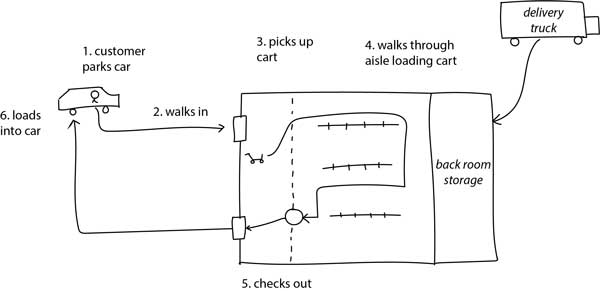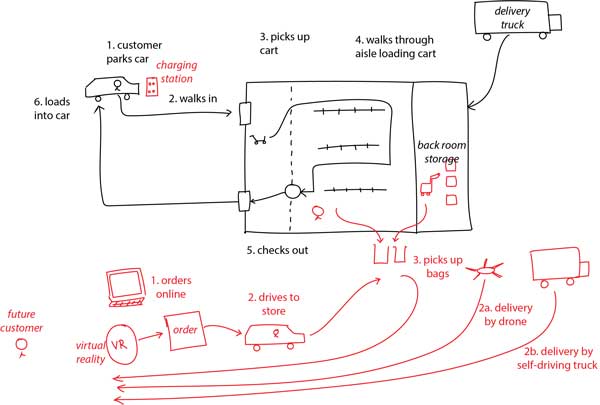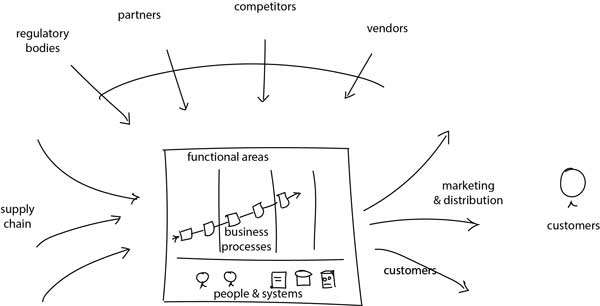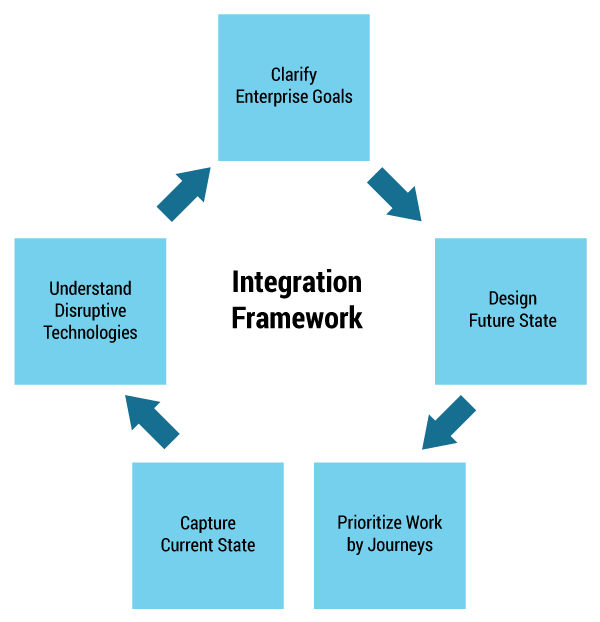Current Challenges
Earlier this year, Fukoku Mutual Life Insurance announced that it planned to replace 34 white-collar workers with IBM’s Watson Explorer, a machine with cognitive capabilities. It is the dawn of the cognitive era, and we will see more and more disruptive technologies being introduced in the business environment. How do we prepare for this?
The business environment is changing at a faster rate than ever before. One of the drivers of change is clearly technology, which is disrupting business at multiple levels. Within the organization, technology is disrupting business processes and the roles people play. Outside the organization, technology is enabling new business models, leading to new forms of competition. Today’s customers have much more access to technology and devices, and they expect to use those to interact with businesses. They also expect businesses to offer more sophisticated, smarter products and services tailored to their needs and preferences.
Multiple Dimensions of Change
To complicate matters, we face a plethora of disrupting technologies such as virtual reality (VR), cloud computing, mobile computing, blockchain, artificial intelligence (AI — including machine learning, deep learning, and cognitive systems), and more. However, disruptive technology can offer a business tremendous value if it is integrated well into the organization. Disruptive technologies may enhance old processes or enable new ways to do things.
In the earlier days of the Internet, integrating one technology was hard enough. How can we integrate multiple technologies into today’s businesses? What parts of the business a company chooses to build in-house and what parts it chooses to outsource is a strategic decision. Apple, for example, has created an ecosystem in which all its products are intended to connect seamlessly with one another for a richer user experience. United Airlines, on the other hand, focuses only on the flight segment of a person’s travel. Understanding the desired customer experiences will help companies decide how to strategically leverage vendors that specialize in specific solutions, while at the same time integrate with their internal business processes. Examples of such providers include LinkedIn’s social platform, Uber’s ride sharing, and Visa’s payment processing.
We need a structured approach to effectively deal with multiple dimensions of these challenges. In this article, we will explore a framework for integrating new technologies into business processes. To make the framework more concrete, we will look at the impact of two specific technologies — artificial intelligence and virtual reality — on a hypothetical grocery store chain. Of course, you can adapt the framework for your own industry and include the technologies that are relevant to your context.
We will examine the impacts of technologies on multiple dimensions, including people, processes, customer experience, the organization’s existing technology infrastructure, and business models. These are practical issues managers face. Some of their questions have centered around how to evaluate different technologies, what impact they will have on the organization, how much they will cost, when they should start working on them, and so on.
The Ecosystem
A business operates within an ecosystem that includes the entities to which it connects in order to serve its customers. This ecosystem may include its suppliers, service providers, competitors, governing bodies, other stakeholders, and even intangibles such as the interest rate, customer preferences and desires, and so forth.
To adapt to changes in the business ecosystem, many organizations are embarking upon an exercise called “digital transformation,” in which technology plays a significant role. The intent is for businesses to be more relevant to their customers, who are demanding much more than they have in the past.
Digital transformation is a complex and difficult exercise. This is because businesses are doing many things simultaneously: they are modernizing existing systems, reconnecting those systems to the existing network, modernizing some parts of the network, introducing new and often disruptive technologies into the organization, and connecting these new technologies to existing or upgraded business processes. Essentially, there are too many parts and more avenues for failure.
Organizations often experiment with ideas in isolation without giving due consideration to how an idea fits within the larger context of the business, much less the business ecosystem. Thomas Edison invented the electric light bulb, but without a mechanism to produce electricity, distribute it, and charge for its usage — without the supporting ecosystem, in other words — the light bulb would not have been very useful.
The same principle applies to individual experiments in AI and other technologies. We need to understand how technologies integrate into the ecosystem of the organization. For example, if our experiments with machine learning show that we can predict customer purchase behaviors, how could that concept be integrated into the purchasing process? What effect would that have on social media feeds or the psyche of the customer? How could that affect inventory?
The Framework
Disruptive technologies need to be integrated to achieve well-defined business goals, such as improving operational efficiencies, automation, customer experiences, and enterprise asset management or launching new products or services. To transform your organization, you need to understand and model the current state, model the desired future state, and identify the work that will help your organization move toward that future.
As an example, we will use a lightweight exercise for the retail food industry, since many of us are familiar with how a grocery store operates. A grocery store and two disruptive technologies will illustrate some basic concepts.
Visualize the Current State
Consider a hypothetical US grocery store chain called Big Grocers, which has 2,739 retail locations in 32 states. Most stores are profitable and currently operate as any typical grocery store does. If you are a customer, you drive to the store, park your car, walk in, take a shopping cart, walk through the aisles to load your items in your cart, head to the checkout counter to have the items scanned by a cashier, bag them, and take the cart back to the parking lot to load the groceries into your car.
The easiest way for most business people to understand the customer’s shopping experience is to depict it visually. While a process map is a common depiction, a simple illustration such as the one shown in Figure 1 is more useful for our purposes.

Figure 1 — The current state of Big Grocers.
Viewing this current-state picture of the shopping experience, we might immediately see many possible areas Big Grocers could change in the future. What should the customer experience be in the future (say, five years out)? Before we explore that question, it is instructive to understand two things:
- What technological advances have been made in recent years, and how can they help the business?
- What do customers want to accomplish, and what matters to them (convenience, relationship, loyalty, etc.)?
There might be some business constraints, of course, but focusing on them might take some solutions out of consideration before they have even had a chance to be analyzed and debated. We can apply the constraints in a later phase, or seek ways to mitigate them.
Understand Available Technology
Technology is integral to any large business today, and judiciously leveraging it gives some firms a competitive advantage. Airbnb, for example, created a different business model by leveraging technology to compete directly with the hotel industry.
Business managers do not need to understand how technologies work, but they do need to understand what each can do. With this knowledge, they can better understand where a technology can fit into the ecosystem.
While not all disruptive technologies will be applicable in your domain, you won’t know which ones are relevant and which ones aren’t until you think them through in the context of your industry. Hence, you will always need to keep abreast of technology. Lean on your IT department and people who are passionate about technology to help you.
Incorporate Company Goals and Strategy
The future state of the business cannot be designed in isolation; we must consider the internal and external environment.
Say Big Grocers has identified that its current largest customer base is above the age of 35, but there is a big opportunity to cater to younger adults. Customers in the young adult segment have different characteristics and needs. They are digitally savvy; they have relatively little money, since they may be just starting out on their careers; they may be single or recently married; if they have children, those children will be relatively young; and they tend to be busy people.
The store wants to grow its market share in the young adult segment. If we impose the characteristics and needs of this segment on the future state, we can virtually walk through a shopping experience as a young adult. Before creating a future state, however, we should understand the company goals and strategies.
To prove the point, say that the company’s goals call for increasing the market share among the older generation instead. This segment typically has more money and is not technically savvy. They will not use virtual reality or any of the disruptive technologies for shopping. In that case, the company may still need to find ways to integrate technology into the organization, but it will not be integrated with the customer experience. Rather, it will be integrated at the back end to mature the distribution and supply chain management processes.
Visualize the Future State
In our grocery store example, let’s consider some ways the business might integrate disruptive technology. It is useful to “walk in the customers’ shoes” as an exercise, but since we cannot do that physically, we will do it virtually.
Let’s start with the first step, where the customer drives to the store and parks their car. In the future, this may be a fully electric, self-driving car. Would Big Grocers want to have electric charging stations so the car can be charging while the customer shops? Would there be a special section for such cars? Would customers even come to the store in the first place, or would they prefer to order online and have the groceries delivered by drones or self-driving trucks? Would the company then want to reduce the size of the parking lot? Would the store itself be smaller because fewer customers would be visiting the physical location?
We can see how a single question has multiple implications. The possible options branch out in many ways. Figure 2 shows some possible future enhancements in red.

Figure 2 — The future state of Big Grocers in relation to the current state.
We can ask similar questions of other stages in the journey. For example, say the customer shops through a VR-enabled device. They can walk through a virtual store, pick out items from the virtual shelves, and drop them in a virtual cart. Since fewer customers are coming to the store, we could reduce the shelf space and keep most items in the back storage area. This would also make it easier for robots to pick out products and box them.
We could track what’s on the shelves, what’s in the back storage area, what products have expired and need to be removed, what products have to be reordered, and so on. Operations would be streamlined because we will have more data, and customers’ experiences will be attuned to their specific needs. This data can be used to make inferences about the trends and customer expectations, using the discipline of machine learning.
With VR, the store configuration and even decor could change for each customer based on their preferences. If a customer was identified as vegetarian, perhaps the virtual store would hide the meat section.
Amazon is experimenting with a store concept through its Amazon Go project, wherein the customer can pick out the items they want and walk out. The items will automatically be charged to the customer’s credit card.
Start with the Customer Experience
What is customer experience–based transformation? Think of all the reasons your customer interacts with your company. Maybe it is for sales, maybe for service, or maybe just to find out some information. The term “customer” is used in a broad sense and includes internal customers as well.
The different paths that each customer goes through for a specific need, such as to purchase products from your company, may be slightly different. However, a set of capabilities is required to support each path. If a specific path is relatively more important, you could use that as a basis to prioritize work. You could measure criticality based on a number of factors. Perhaps the volume of customers interacting through a particular path is high, and by focusing on that path you can positively impact a large number of customers.
In the Big Grocers example, we may want to focus on individual customers who purchase groceries at the store. We have already depicted possible enhancements we can make to that journey. This is captured in the future-state blueprint (or architecture).
The Role of Architecture
Architecture provides a mechanism for companies to take a systematic approach to digital transformation. Exploiting architectural principles such as modularity and reconfigurability will ensure that the transformation is built on a strong foundation. That in turn ensures business agility.
Architectural Framework
In a recent Cutter Business Technology Journal article, Joe Peppard and John Thorp introduce a framework for digital transformation with four facets:
- Strategy — choosing the right things to do
- Architecture — doing them the right way
- Delivery — getting them done well
- Value — getting the benefits
In this article, we will focus on the architectural facet.
To accomplish the transformation, many functional areas within the organization have to collaborate. The future-state grocery store customer experience will not be possible without collaboration across the functional areas of the organization, as well as collaboration between business and IT.
Architectural Blueprint
The scope of the architecture should include both business and IT. Architecture provides the blueprints for transformation; the current state is captured in one blueprint and the desired future state in another. Then we can look across both blueprints to identify areas that have to change, and by how much. Figures 1 and 2 are essentially examples of those blueprints, although we can make them more formal if desired.
Companies typically use many approaches to enhance their capabilities to ultimately transform. If a company is siloed by functional area, we may find capabilities being developed within one functional area with little consideration for what’s happening outside that area. If the company is project-based, we may find capabilities being developed within projects, while integration across those projects is usually an afterthought.
Another way to enhance capabilities is to take a customer-centric view and develop capabilities along a customer journey or value stream. We will focus on this last one, since that naturally resolves the integration challenges if executed well.
In this approach, we identify the customer experiences that matter the most and focus on those. This gives us a starting point to identify all the impacted business areas and technologies that have to transform. Updates in some areas may also trigger updates in others, because the organization is a network of connected elements. Adhering to architectural principles will ensure the overall system flexibility as the organization continues its transformation journey.
Architectural Elements
For an effective framework, we’ll need to model our business and the elements that make it run, model the constraints, model the capabilities, and model the ecosystem outside the business.
As we visualize the grocery store, we can identify many elements that enable the operations. Some of them are tangible and some intangible. Tangible elements include the parking lot, carts, shelves, items on the shelves, refrigerators, computing hardware, cash registers, people, and so on. Intangible things include processes, data, strategy, goals, needs, leadership, and the like.
The interaction of these elements with one another is what forms the architecture of the business. One innovative way to think about possible future states is to imagine that an element is missing or is replaced. Airbnb came up with a new business model for lodging by removing the need to own the accommodation spaces.
In the Big Grocers example, what would happen if the store did not have physical carts? Perhaps people could be given a scanner or even use an app on their phone to scan items as they walk through the aisles. Their selections would be tracked, bags containing their items would be waiting for them at the door, and they could just walk out with them, as their credit card would be charged automatically. Sam’s Club uses a mechanism that closely mirrors this scenario with its Scan & Go app.
The Ecosystem Context
We’ve briefly discussed the business operations, the architectural elements that enable the customer experiences, and the business models. All this was done with the knowledge of what technology can enable, and considering each element of the architecture, to see if one or more of those can be replaced by the disruptive technology.
Once the architectural elements are identified, we can capture them in an easily managed format. Typically, this is a database.
Using the grocery store example as a basis, let’s model the major parts of a business (see Figure 3). Any business typically offers products or services to its customers; has many functional areas such as sales, marketing, accounting, and so on; and is enabled by business processes, which are supported by people and technology. There is a supply chain and distribution channels. The company’s ecosystem may also include partners, regulatory bodies, and competitors that have an influence on the operations.

Figure 3 — Ecosystem of the organization.
There are many ways to model this business. In the Big Grocers example, we may model the physical aspects of each store as if we were looking at it from the air. We will see the store layout and be able to discern the parking lot, the entrance, the different designated shopping areas, the offices, the storage area, the delivery docks, and so on.
Alternatively, we could model the same store conceptually as a set of capabilities it needs to leverage, including distribution management, sourcing management, people management, inventory management, vendor management, and business strategy and planning.
Yet another way to model the store would be to model the customer journeys. Some customers are people who walk into the store, some may be restaurants that have the groceries ordered through an account manager and delivered, and some may be event halls that source the groceries directly from the distribution centers. Each type of customer goes through different journeys, which can be modeled as well.
As you can see, the same physical store may be modeled in different ways depending upon what you want to understand about it. You may create multiple models that reflect different perspectives.
To Recap
Through the Big Grocers example, we essentially identified the framework for integrating disruptive technology into the enterprise. The major steps in the framework include the following:
- Capture current state to ensure that all stakeholders have a common understanding of the challenges.
- Understand where technology can be applied to enhance the end-to-end processes in a future state.
- Understand company goals so that the work to be done in harnessing disruptive technologies is aligned with such goals.
- Design the desired future state, showing where technology is used, what value it will provide, and how the customer experience will change.
- Prioritize work by customer journeys. The term “customer” is used in a broad sense and could refer to internal or external customers.
The Framework Systematizes Transformation
These steps will then set the stage to create a roadmap for implementation, which is outside the scope of this article. The framework is depicted in Figure 4.

Figure 4 — The Disruptive Technology Integration Framework.
Putting It All Together
Integrating disruptive technology into your organization is a challenging exercise. Most companies have an already entrenched business model that can be difficult to change, even if the desire exists. For example, Barnes & Noble cannot simply change to the Amazon model.
Disruptive technology presents many options, and trying to implement them all will result in spectacular failures. So the key is to prioritize. Prioritization should be driven by the company’s goals and strategies and facilitated by architecture. The various functional areas have to collaborate in this task because integration cannot happen in isolation.
The framework outlined above can help you ensure successful integration of disruptive technology. It lets you depict a long-term vision, while enabling you to progress incrementally toward that vision. Each functional area can contribute its portion of the work, while understanding the enterprise goals. Architecture is a great vehicle for that. Often, a team is tasked with keeping the architecture up to date as well as facilitating integration across functional areas. This team also develops standards so that the architectures of the individual functional areas can be “connected” together into a holistic view.
The framework is modular and scalable. It allows for multiple pieces of the vision to be worked on simultaneously. In the Big Grocers example, while one effort may focus on integrating disruptive technologies into the store’s customer-facing processes, another may focus on upgrading the processes and technologies of the supply chain. While collaboration is critical, each area has leeway in how it designs and develops its internal work. Some companies establish overall enterprise standards, while others let different areas develop independently as long as the integration “interfaces” are well defined and adhered to. This allows for siloed organizations to collaborate without overhauling the whole organizational structure.
The framework reflects reality and should include the real-world possibilities and constraints. The possibilities help identify what can be changed (such as a new way of sourcing raw material), and the constraints help identify what cannot be changed (such as keeping the same business model). You can still choose to remove the constraints and change your business model, for example, but such a change needs to be shown in a different architecture that represents a different desired future.
Companies need to take a structured approach to harnessing disruptive technologies. While prototyping and experimentation are required, for most companies such experimentation should be done with a holistic plan in mind. That way, the prototypes can be developed further and integrated into the customer journeys of interest. This incremental yet deliberate execution will help reduce risk and increase the likelihood of success.



